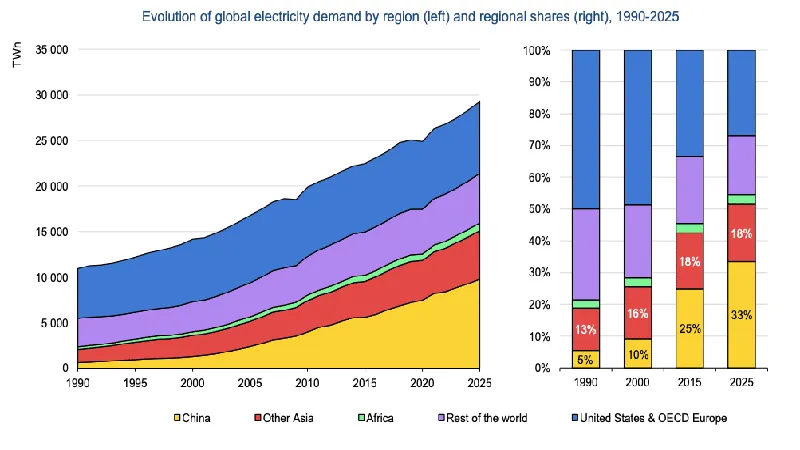
Global Electricity Demand Set to Rise by 4% Annually
As the world rapidly approaches a new energy era, the demand for electricity is set to surge, with projections indicating a 4% annual growth rate through 2027. This escalating need is driven by diverse sectors such as industries, data centers, and air conditioning, which are now at the forefront of this electricity revolution. The International Energy Agency’s recent report highlights the staggering challenge ahead: to meet this demand, we must add generating capacity equivalent to Japan’s total output every year. This introduction sets the stage for a deeper exploration of how emerging economies, particularly China, are poised to lead this charge and the critical role of low-carbon energy sources in shaping our future.
| Category | Details |
|---|---|
| Global Electricity Demand Growth | Expected to grow by 4% annually through 2027 |
| Main Contributors to Growth | Industries, data centers, air conditioning |
| Total New Generating Capacity Needed | More than Japan’s total capacity added every year |
| Growth in Emerging Economies | Expected to account for 85% of the growth |
| China’s Electricity Growth Rate | 6% annual growth from industries including solar panels and electric vehicles |
| U.S. Growth Rate | Lower than China, equivalent to California’s current demand by 2027 |
| Sources to Meet Demand Growth | Primarily low-carbon sources: renewables and nuclear energy |
Understanding Global Electricity Demand
Electricity is something we use every day for many things, like turning on lights and powering our gadgets. Right now, experts believe that the demand for electricity around the world will grow by 4% each year until 2027. This means that each year, we will need 4% more electricity than the year before! This growth is important because it shows how much our world relies on electricity for its daily activities.
The International Energy Agency (IEA) has studied this electricity demand and shared their findings. They predict that industries, data centers, and air conditioning will be some of the biggest reasons for this increase in electricity needs. To keep up with the growing demand, we will need to build more electricity-producing facilities than what Japan has right now, every single year until 2027.
Frequently Asked Questions
What is the forecast for global electricity demand by 2027?
Global electricity demand is expected to grow by 4% annually through 2027, requiring significant increases in generating capacity each year.
Which sectors will drive electricity demand growth?
Industries, data centers, and air conditioning are predicted to contribute to the fastest growth in electricity demand in the coming years.
How much electricity will be needed annually until 2027?
The world will need 4% more electricity each year until 2027, necessitating the addition of generating capacity exceeding Japan’s total.
Which countries will see the most electricity demand growth?
Emerging and developing economies will account for 85% of the growth, particularly driven by industries in China.
What is the growth rate of electricity demand in China?
China’s electricity demand is expected to grow at an annual rate of 6%, mainly from industries like solar panel and electric vehicle manufacturing.
How does U.S. electricity demand growth compare to China’s?
U.S. electricity demand growth will be lower than China’s but significant, expected to match California’s current demand by 2027.
What sources will meet the rising electricity demand?
Low-carbon sources, mainly renewables and nuclear energy, are projected to fulfill nearly all global demand growth.
Summary
Global electricity demand is set to rise by 4% each year until 2027, driven mainly by industries, data centers, and air conditioning. The International Energy Agency forecasts that to meet this demand, the world will need to generate more electricity than Japan produces annually. Emerging economies, especially in China, will make up 85% of this growth, with Chinese industries contributing significantly. While the U.S. will see growth too, it will be less than China’s, comparable to California’s current demand. The increase in electricity needs will largely be met by renewable and nuclear energy sources.